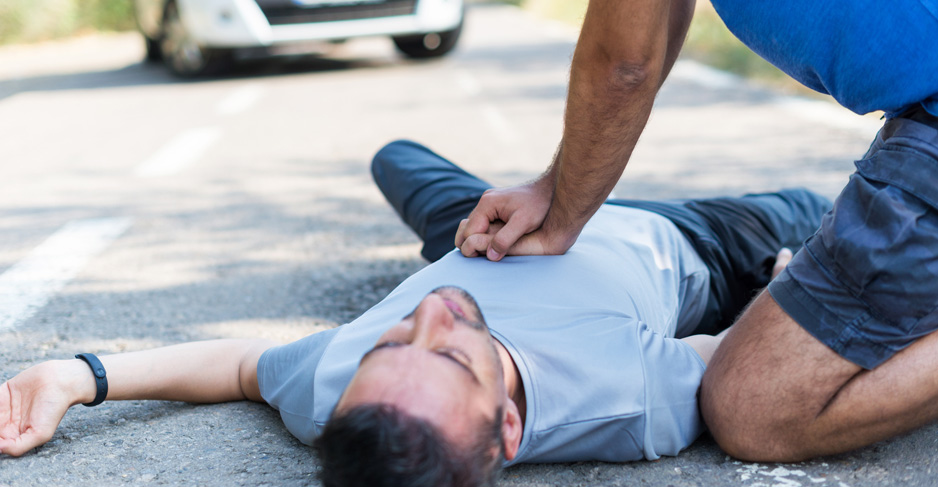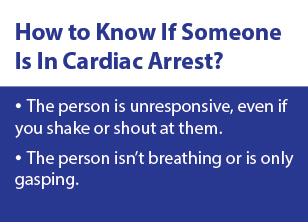The Hero Within: Knowing Hands-Only CPR & How To Use An AED Can Save Lives
Posted on by
The first week of June was National CPR/AED Awareness Week. In belated observance, Public Health Matters looks at how people can confidently help someone in cardiac arrest.
The numbers are staggering. About 350,000 people have a cardiac arrest outside of the hospital each year, and about 9 in 10 of them die. (1)
Bystanders and family members are often first to respond in a medical emergency, but, according to some research, they may hesitate to do cardiopulmonary resuscitation (CPR)—even if they have been trained in CPR and how to use an automated external defibrillator (AED). The most common reasons for responders’ reluctance are mistrust of their abilities and fear of injuring the victim, according to a study in Emergency Medicine Journal. (2)
That was before the coronavirus disease 2019 (COVID-19) outbreak and CDC’s recommendations to keep a physical distance of at least 6 feet from other people and wear a mask in public settings.
Take Action
Cardiac arrests still happen outside of hospitals during the COVID-19 outbreak, and victims still need help. If you are in the position to save a life, you should.
CPR keeps blood flowing and provides oxygen to the brain and other vital organs, giving the victim a better chance of a full recovery. If performed in the first few minutes of cardiac arrest, it can double or triple a person’s chance of survival. (1)
If you are uncomfortable with putting your mouth on a stranger’s mouth because the other person may have COVID-19, you can do hands-only CPR until help arrives, according to the American Heart Association (AHA). (3)
You don’t need a special certification or formal training to do hands-only CPR. If cardiac arrest happens to someone near you, don’t be afraid to take action:
- Call 9-1-1 right away. If another bystander is nearby, save time by asking that person to call 9-1-1 and look for an AED while you begin CPR. All 50 states have laws or regulations requiring AEDs in that public gathering places. (4)
- Give hands-only CPR. Push down hard and fast in the center of the chest at a rate of 100 to 120 compressions or pushes a minute. Let the chest come back up to its normal position after each push. AHA recommends timing your pushes to the beat of the song “Stayin’ Alive.” This method of CPR is called “hands-only” and does not involve breathing into the person’s mouth.
- Keep giving hands-only CPR until medical professionals arrive or until a person with formal CPR training can take over.
You CAN make a difference, but you must be willing to help.
Education at Your Fingertips
 Being prepared for an emergency is more about knowledge than supplies.
Being prepared for an emergency is more about knowledge than supplies.
- Learn how to perform hands-only CPR from home. Watch AHA’s instructional video and share the link with others.
- Learn how to use an AED. An AED is a device that easily walks you through how to use it on a person in cardiac arrest.
- Learn to recognize the signs of cardiac arrest. It’s important to know that cardiac arrest can happen at any age. If you see a teen or adult suddenly collapse, call 9-1-1 and begin hands-only CPR.
- Learn more about the Good Samaritan Law where you live. The general principal of the Good Samaritan Law provides for protection from claims of negligence for those who provide care without exception of payment. All 50 states have a Good Samaritan Law, but the details of these laws can vary from state to state. (5)
- Take a CPR training course in person when it is again safe to gather in groups. CPR with compressions and breaths is recommended for infants, children, victims of drowning or drug overdose, or people who collapse because of breathing problems. (6) If you are unwilling to perform rescue breaths with infants or children, you should do chest compressions until medical help arrives. (7)
Visit Prepare Your Health for more information on how to prepare for emergencies.
Resources
References
- https://www.cdc.gov/features/learn-cpr/index.html
- https://emj.bmj.com/content/36/11/660
- https://cpr.heart.org/-/media/cpr-files/resources/covid-19-resources-for-cpr-training/community-faqs-covid19-and-cpr-training.pdf?la=en
- https://www.ncsl.org/research/health/laws-on-cardiac-arrest-and-defibrillators-aeds.aspx
- https://www.ncbi.nlm.nih.gov/books/NBK542176/
- https://cpr.heart.org/-/media/cpr-files/courses-and-kits/hands-only-cpr/handsonly-cpr-faqs-ucm_494175.pdf?la=en
- https://pubmed.ncbi.nlm.nih.gov/29114009/?from_term=compression+only+cpr+infant&from_pos=1
Thanks in advance for your comments on this Public Health Matters post. Please note that the CDC does not give personal medical advice. If you are concerned you have a disease or condition, talk to your doctor.
Have a question for CDC? CDC-INFO (http://www.cdc.gov/cdc-info/index.html) offers live agents by phone and email to help you find the latest, reliable, and science-based health information on more than 750 health topics.
Posted on by

